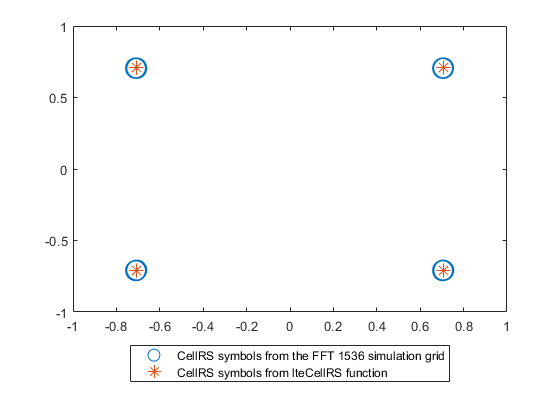Application of FFT 1536 block in LTE OFDM Demodulation
This example shows how to use the FFT 1536 block in LTE OFDM demodulation.
Generate transmitter waveform.
Remove cyclic prefix.
Prepare inputs for FFT 1536 simulation.
Form resource grid.
Compare the CellRS symbols from the grid with that of
lteCellRSfunction.Generate HDL code.
Generate transmitter waveform.
cfg = lteTestModel('1.1','15MHz'); cfg.TotSubframes = 1; tx = lteTestModelTool(cfg);
The above transmitter waveform generation uses a 2048-point FFT, which results in a scaling factor of  in OFDM modulation. If a 1536-point FFT were used, the waveform would have a scaling factor of
in OFDM modulation. If a 1536-point FFT were used, the waveform would have a scaling factor of  . This example multiplies the waveform by a factor of
. This example multiplies the waveform by a factor of  to achieve the correct scaling.
to achieve the correct scaling.
tx = tx*(2048/1536);
To achieve a 23.04 Msps sampling rate, resample the tx samples by 
rx = resample(tx,3,4); % rate conversion from 30.72Msps to 23.04Msps
Remove cyclic prefix. The first symbol of each slot has 12 additional CP samples.
rx(11520+1:11520+12) = []; % discard 12 CP samples in slot 2 rx(1:12) = []; % discard 12 CP samples in slot 1 rx = reshape(rx,108+1536,14); % reshape to form 14 OFDM symbols rx(1:108,:) = []; % discard remaining 108 CP samples from all symbols
Prepare inputs for FFT 1536 simulation.
SampleTime = 4.3e-8; % 1/23.04e6; data = rx(:); valid = true(1536*14,1); data = fi(data,1,22,20); dataIn = timeseries(data,(0:length(data)-1).'*SampleTime); validIn = timeseries(valid,(0:length(valid)-1).'*SampleTime); FFT1536Latency = 3180; NofClks = FFT1536Latency+length(data); % number of simulation clock cycles StopTime = (NofClks)*SampleTime; open_system HDLFFT1536model; sim HDLFFT1536model;

simOut = dataOut(validOut); simOut = double(simOut(:)*1536);
Form the resource grid and remove the DC subcarrier.
fftOut = fftshift(reshape(simOut,1536,14)); resourceGrid = fftOut(318+1:318+1+900,:); resourceGrid(900/2+1,:) = [];
Compare the CellRS symbols from the grid with the symbols returned from the lteCellRS function.
cellRS = lteCellRS(cfg); cellRSIndices = lteCellRSIndices(cfg); simCellRS = resourceGrid(cellRSIndices); figure; plot(real(simCellRS),imag(simCellRS),'o','MarkerSize',15); hold on; plot(real(cellRS),imag(cellRS),'*','MarkerSize',10) legend('CellRS symbols from the FFT 1536 simulation grid'... ,'CellRS symbols from lteCellRS function','Location','southoutside') axis([-1 1 -1 1]);

To generate HDL code for the FFT 1536 block, you must have an HDL Coder™ license. To generate HDL code from the FFT 1536 block in this model, right-click the block and select Create Subsystem from Selection. Then right-click the subsystem and select HDL Code > Generate HDL Code for Subsystem.